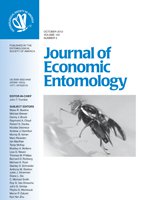The consumption and food transfer efficiency of two commercially used termite bait materials, southern yellow pine wood and cardboard, and one potential bait material, maize (Zeamays L.) cob, were evaluated for use against the Formosan subterranean termite, Coptotermes formosanus Shiraki (Isoptera: Rhinotermitidae), in the laboratory. In the no-choice test, the consumption of wood and cob was similar and significantly more than cardboard. Tunneling under the food sources was similar. In the two-choice test, the consumption was cob > wood, wood > cardboard, cob = cardboard, and tunneling under these choices was cob = wood, wood = cardboard, cob > cardboard. In the three-choice test, no significant difference was detected in consumption, but tunnels made under the cob were significantly more than wood and cardboard. Nile blue A was used to study food transfer of bait material among termite cohorts. Dyed cardboard, cob, or wood (0.1% Nile blue A) was provided to termites as food. Termites feeding on wood turned blue in significantly greater number at 6 h compared with cardboard and cob, but there was no significant difference after 12 h. Blue termites feeding on different bait materials were then collected and combined with undyed termites. When undyed (white) termites were placed with blue termites and food (wood block), termites turned blue in the same percentage regardless of original bait material fed on. However, when no food was provided (starvation group), the rate of white termites turning blue was dramatic; in dyed wood treatment, significantly more termites turned blue than that of cardboard, although neither were significantly different from cob. Our study is the first to show that, cob, an otherwise waste product of the food and biofuel industry, is as efficient as wood and cardboard as a termite bait matrix.
How to translate text using browser tools
1 October 2012
Evaluation of Three Bait Materials and their Food Transfer Efficiency in Formosan Subterranean Termites (Isoptera: Rhinotermitidae)
Cai Wang,
Gregg Henderson
ACCESS THE FULL ARTICLE
It is not available for individual sale.
This article is only available to subscribers.
It is not available for individual sale.
It is not available for individual sale.

Journal of Economic Entomology
Vol. 105 • No. 5
October 2012
Vol. 105 • No. 5
October 2012
baiting system
cardboard
Coptotermes formosanus
maize cob
pine wood




